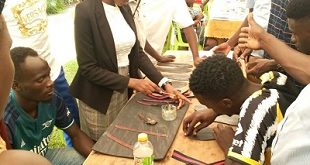
Ugandan scientists seek integrated approach to tackle killer disease
Scientists at the Uganda Virus Research Institute (UVRI) plans to undertake a research on genetically engineered mosquitoes to tackle malaria. Dr. Jonathan Kayondo, the principal investigator Target Malaria Uganda and Senior Research Officer at UVRI had an email interview with The Independent’s Isaac Khisa about the research and here are the excerpts:
What progress has been made since the start of the research?
In Uganda, Target Malaria’s research is still in early stages, currently at facility readiness. The Uganda Virus Research Institute became a primary Target Malaria project site in 2016. We have been laying the research groundwork by setting up the necessary infrastructure and building capacity of the teams. We constructed a new Arthropod Containment Level 2 (ACL2) insectary to facilitate future studies on development and evaluation of genetically modified mosquitoes following international containment guidelines and best practices. It was inaugurated in July 2019. Our teams are currently testing the facility for functionality by studying the local wild mosquitoes under containment and developing standard operating procedures (SOPs) as part of the capacity building efforts. We are also busy developing stakeholder engagement strategies and preparing to apply for regulatory approval for the next stage of our research.
How do you expect the new technology to work?
The consortium is working to develop a genetically modified mosquito that can be released into a target population to reduce the number of mosquitoes that transmit malaria. We are adapting a natural genetic mechanism called gene drive, to spread a genetic modification in malaria mosquitoes that would affect the mosquitoes’ ability to reproduce. Gene drive is a process that allows the biased inheritance of certain genes from one generation to another, until the gene reaches a frequency where it starts to impact mosquito reproductive ability. Gene drive technologies hold the promise of being a self-sustaining and cost-effective method to reduce the population of malaria mosquitoes. By reducing the population of malaria mosquitoes, we aim to reduce the transmission of the disease.
What are some of the benefits of the new technology provides compared with current technologies used such as using mosquito treated nets or chemical sprays etc.?
With over 200 million new cases of malaria each year, the world needs an integrated approach to tackle malaria. In Uganda alone, over 11 million cases were recorded and over 13000 deaths in 2019 (World Malaria Report 2020). Complementing other control methods such as the use of mosquito treated nets and insecticides, our project aims to fight malaria in a manner that is long-term, sustainable, and cost effective. Our technology is expected to be simple and cost effective to implement because the mosquitoes themselves do the work of stopping malaria. The technology could work hand in hand with other methods to combat malaria and address malaria control in an innovative way. It would be particularly effective in Africa especially in rural areas with weak health systems and remote populations because it would not require multiple interventions and could last over a period of time long enough to stop transmission.
When is the new technology going to be tried out in the community as part of the study and why? Or it will remain in the confined field trials like it is with the case of crop research due to absence of biotechnology law?
Target Malaria’s research is still in the lab stages and it will take several years before we have a technology that could be “tried out in the communities”. However, any activities that involve the communities would be conditional on obtaining permission from the regulatory authority in Uganda and on agreement from the local communities directly affected by the technology.
Which organisation is funding the research and at what cost?
Target Malaria receives core funding from the Bill & Melinda Gates Foundation and from the Open
Philanthropy Project Fund, an advised fund of Silicon Valley Community Foundation. Some individual
labs also received additional funding from a variety of sources to support their work, including the
Department for Food Environment and Rural Affairs-DEFRA (UK), the European Commission, the MRC
Centre for Global Infectious Disease Analysis (UK), the National Institutes of Health-NIH (USA), the
Uganda National Council for Science and Technology-UNCST, Ugandan Ministry of Health, the
Wellcome Trust (UK), and the World Bank. The research in Uganda requires over $ 1 million annually
for the current stage.
Where has similar research been done? What were the results?
The kind of research that Target Malaria is involved in, has not been done anywhere before. However, as a research consortium, this research involves other partner countries in Africa that include Burkina Faso, Mali, Ghana and Cape Verde. Our colleagues at the IRSS in Burkina Faso did the first release of non-gene drive genetically modified sterile male mosquitoes in July 2019.
****
 The Independent Uganda: You get the Truth we Pay the Price
The Independent Uganda: You get the Truth we Pay the Price


